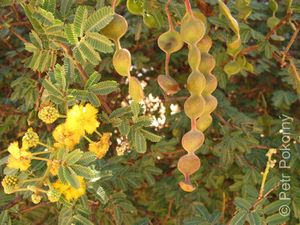Note: This is a project under development. The articles on this wiki are just being initiated and broadly incomplete. You can Help creating new pages.
Acacia nilotica - Aaavartaki
Babul or Vachellia nilotica widely known by the taxonomic synonym Acacia nilotica, or common names Gum arabic, कीकर Kikar (Hindi), बबूल Babul (Marathi), Nalla tumma (Telugu), Babli (Kannada), Karivelam (Malayalam), kaRuvELai (Tamil), Babaria (Gujarati) Botanical name: Acacia nilotica subsp, indica[1]
Description
Vachellia nilotica is a tree 5–20 m high with a dense spheric crown, stems and branches usually dark to black coloured, fissured bark, grey-pinkish slash, exuding a reddish low quality gum. The tree has thin, straight, light, grey spines in axillary pairs, usually in 3 to 12 pairs, 5 to 7.5 cm (3 in) long in young trees, mature trees commonly without thorns. The leaves are bipinnate, with 3–6 pairs of pinnulae and 10–30 pairs of leaflets each, tomentose, rachis with a gland at the bottom of the last pair of pinnulae. Flowers in globulous heads 1.2–1.5 cm in diameter of a bright golden-yellow color, set up either axillary or whorly on peduncles 2–3 cm long located at the end of the branches. Pods are strongly constricted, hairy, white-grey, thick and softly tomentose. Its seeds number approximately 8000/kg.[2]
Uses
- The tender twig of this plant is used as a toothbrush in south-east Africa and India.
- The exudate gum of this tree is known as gum arabic and has been collected from the pharaonic times for the manufacture of medicines, dyes and paints
- The tree's wood is "very durable if water-seasoned" and its uses include tool handles and lumber for boats.[3]
common name
- English - Babul
- Kannada - Babli
- Hindi - कीकर
